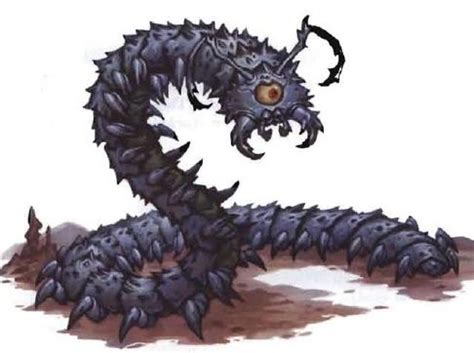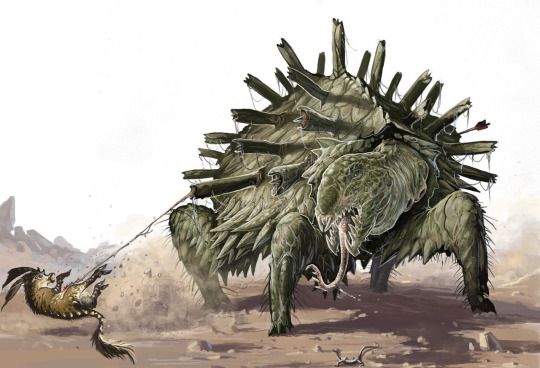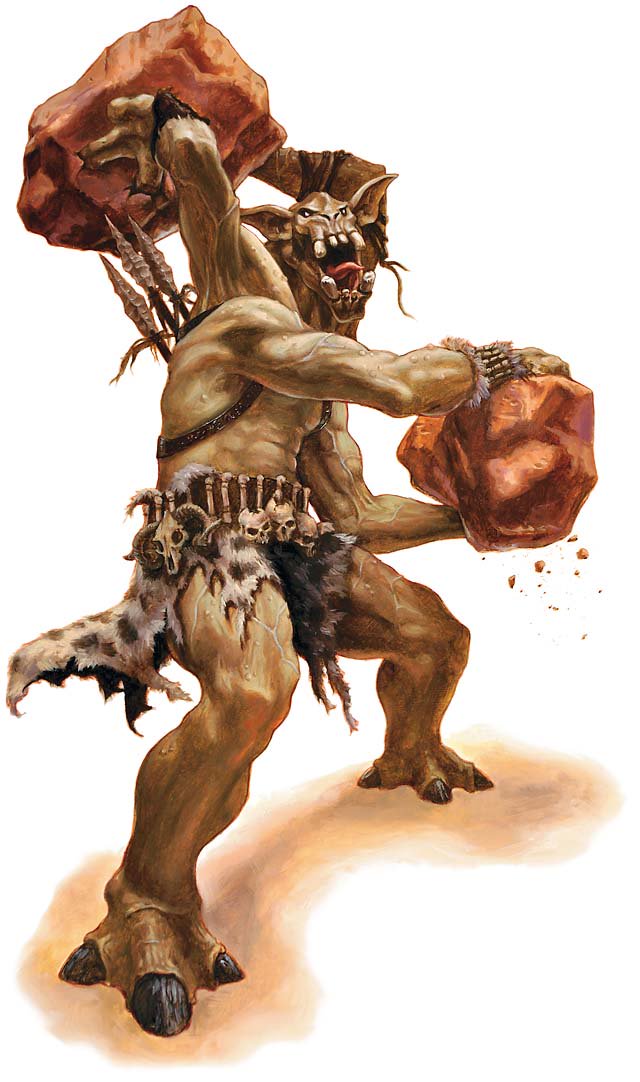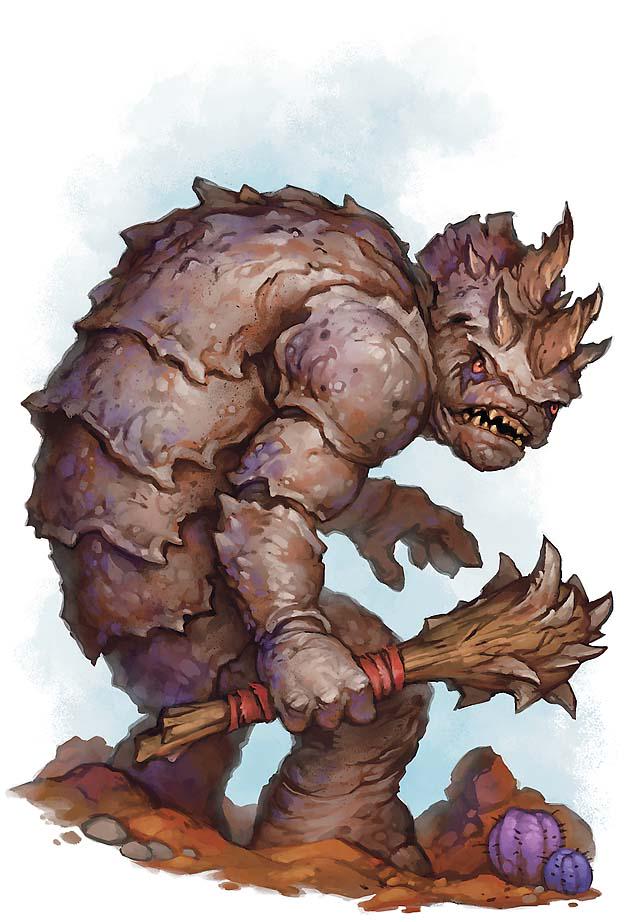Posts
-
Let's Read the Dark Sun Creature Catalog: Cilops

A cilops, which is a giant centipede with one big angry eye on its head. Copyright 2010 Wizards of the Coast. This post is part of a series! Click here to see the rest.
The Lore
The cilops (not to be confused with the cyclops) is the Darker and Sunnier version of Ye Olde Giante Centipede. That means it’s larger, spikier, and has psychic powers. Their name comes from the huge single mammal-like eye they have instead of the more usual compound eyes you find in arthropods.
Unlike other monstrous centipedes, the bite of the cilops is not venomous. The touch of its antennae, however, can psychically paralyze victims or muddle their minds. They can also psychically track victims over short distances - it’s very hard to hide from these things once they caught your scent.
In the wild, cilopses gather in the same places you can find mundane centipedes - any area where there’s a reasonable amount of shade and water. You’re more likely to find them outside of the wild, however, as Templar patrols from every city love to use trained cilopses as both trackers and attack animals.
Some templars or sorcerer-kings are also fond of raising particularly large and vicious specimens and letting them loose on the city to wreak some havoc and terrorize the population into compliance.
The Numbers
Cilopses are Large Natural Beasts. They have Darkvision, some sort of antenna power that varies with the stat block, and the signature power Follow Psychic Trail. This is a minor-action encounter power that lets them choose a creature they can see. Until the end of the encounter that creature grants combat advantage to the cilops, and cannot hide from it.
The combat advantage is pretty useful during a fight, but remember that a skill challenge to run away from a cilops-equipped patrol is also an encounter. Don’t let they catch your scent!
Cilops Creeper
A typical specimen such as one might find in the wild, or accompanying a templar strike force. It’s a Level 5 Skirmisher with 60 HP. It has ground and climb speeds of 7, and Resist 5 Psychic.
All of the creeper’s attacks deal 1d6 extra damage if it has Combat Advantage, which is yet another reason for not letting it track you. Its basic bite damages on a hit and lets the creeper shift 2 squares as an effect. Once per encounter it can use its Paralyzing Antennae against a creature granting combat advantage to it, targetting Fortitude. On a hit this damages, dazes, and immobilizes the target for a turn.
Creepers really want to start tracking a specific PC as soon as the fight starts, and then focus fire on their chosen victim starting with an antennae attack and then proceeding to spam the bite.
Cilops Stalker
A chunky terror weapon, the Stalker is a Level 7 Elite Skirmisher with 154 HP. It’s slower and less agile than the Creeper, with a ground speed of only 6 and no climb speed or psychic resistance. However, it makes up for that in bulk.
The Stalker’s pincers have the same bonus against targets granting CA, and its Sudden Rush maneuver (recharge 5+) is excellent against tight formations. It allows the Stalker to shift its speed and move through enemies space during this shift. Whenever it does so, it makes a melee attack vs. the enemy’s Reflex, dealing heavy damage and knocking prone on a hit.
It can still only Follow Psychic Trail once per encounter, but unlike the Creeper it can use its Reach 2 Dazing Antennae once per round with no targeting restrictions. This does lightning damage equivalent to the bite on a hit, and dazes for a turn.
The Stalker also wants to track and focus on one target, and Sudden Rush lets it reach that target even through the party’s defender front line.
Encounters and Final Impressions
As mentioned above, you’re much more likely to encounter these things being used as trackers and attack animals by templars than to meet them in their natural habitats. If you do meet them in the wild, they’re likely to be accompanied by other varieties of giant bug, or by swarms of smaller ones.
Mechanically, they’re giant centipedes with a bit more character, and I imagine they can get pretty annoying when paired with other teammates that specialize in tying PCs down and preventing them from helping the cilops’ chosen victim.
-
Let's Read the Dark Sun Creature Catalog: Chathrang

A chathrang reeling in a small mammal it just caught. Copyright 2010 Wizards of the Coast. This post is part of a series! Click here to see the rest.
The Lore
Chathrangs are big carnivorous tortoises with built-in anti-air artillery. The many spiny protusions on their shells are tubes that can spit out sticky envenomed quills, with or without a tether that lets them reel in their catch. Their usual hunting method is to hide in an oasis amid natural reeds or other plants, wait for small birds or large insects to fly overhead, and shoot them.
If no suitable flying critters are present, they’ll go for land-based prey. They tend to become too enthusiastic or desperate at these times, and might try to reel in something they can’t handle. Like a PC, for example.
Chathrangs usually live and travel in groups of about three. They don’t have a lot of combat ability outside of their one neat trick, so it’s common for them to enter symbiotic relationships with other creatures to share prey in exchange for a bit more protection. When hurt, they behave like other tortoises and hide inside their shells.
Charthrangs are impossible to train, but some people keep them around to “milk” their venom. If a battle against their keepers ends up bursting into the charthrang enclosure, the creatures will follow their instincts.
The Numbers
These critters are Medium Natural Beasts with the Reptile tag and a stately ground speed of 4. They’re Level 9 Artillery with 81 HP, so I guess even a monster described as “relatively weak” rates high-Heroic stats in this world.
The creature’s Spiny Shell acts as an aura (1) that deals 5 damage to anyone who starts their turn inside, but they charthrang doesn’t really want PCs to get that close. Instead, it wants to stay far away and shoot its Range 20 spine shots, which do poison damage on a hit. The beast can increase its rate of fire and use a Spine Volley instead, attacking two targets with one action.
Attaching a sticky strand to a spine turns it into the Poisoned Tether attack, which does the same damage and immobilizes the target. While immobilized by this attack, the target cannot be pushed, pulled, or slid by anything other than the Reel In minor action, which pulls it 5 squares. Escape requires either passing a save as normal, or teleporting.
If the charthrang is damaged by an attack, it can retreat into its shell as a reaction. Until the end of its next turn it’s slowed, can’t attack, gains a +5 to AC, and doubles the damage done by its aura.
Encounters and Final Impressions
Aside from the standard encounter disposition mentioned in the lore, chatharangs are also very amenable to reskinning. If you read the Cactus entry and felt that you needed cactus artillery to complement the lurkers, you can just replace Reptile with Plant on the chathrang stat block and call it a day. Describe them as big spherical cacti that move by rolling around and otherwise behave the same.
The mechanics are interesting. Range 20 is a lot! A cluster of three of these machine-gun tortoises can sit very far back behind a line of 2-4 soldiers or brutes and wreak havoc on the PCs by directly targeting their squishies, and reeling them towards Team Monster’s frontline. Multiple charthrangs can stick their tethers to the same PC and alternate their use of Reel In to bring the victim closer that much faster, too.
That is, of course, if the GM plays them smart. This is absolutely not required, as these are simple animals with a reputation for trying to catch things too dangerous for them to handle.
Still… anti-air tortoises. What a world.
-
Let's Read the Dark Sun Creature Catalog: Cactus

A menacing purple cactus with huge spines. Copyright 2010 Wizards of the Coast. This post is part of a series! Click here to see the rest.
Cacti are an important part of the Athasian ecosystem, and their natural water collection mechanisms are often vital to allow people to survive in its deserts. But in Dark Sun, sometimes the cactus drinks you.
This entry presents two D&D Plant Monsters with that Darker and Sunnier edge to them.
Zombie Cactus
One of the most prized cactus species in Athas is the Flowering Oasis Cactus, a beautiful plant whose sweet fruit can instantly satisfy someone’s hunger or thirst. Finding one of those out in the desert can be a real lifesaver.
The Zombie Cactus takes advantage of this by looking exactly like a Flowering Oasis Cactus to draw its victims in. Its fruit is just as sweet, but it’s filled with mind-affecting poison nectar that dominates those who eat it. If the victim is too wary to eat, the cactus can release a cloud of spores that has the same effect before uncoiling its tendrils to deal with anyone still free. People killed while under the cactus’ influence immediately raise as zombie cactus thralls.
All of this is way too evil to be a coincidence. Sages believe zombie cacti are an engineered bioweapon, the work of slavers employing psychic powers and defiling magic. The creatures proved too uncontrollable to be used as tools, and enough escaped their creators to take root in the wild.
The Numbers
Zombie Cacti are Large Natural Magical Beasts with the Plant tag. Yes, they’re intelligent. They’re also Level 11 Elite Lurkers with 182 HP, Tremorsense 10, and a ground speed of 2 with Earth Walk. Yes, they’re ambulatory.
You’ll usually find the cactus in its Innocuous Form, which is nearly identical to a flowering oasis cactus (Nature DC 27 to notice the difference). It can do nothing in this state except assume its true form as a minor action. While disguised, the cactus has Resist 15 all and Regeneration 5. Wearing the disguise again takes a standard action.
A disguised cactus is still dangerous because of its Poison Fruit, described as a passive trait. It will have between four and eight of these, which can be eaten by another character as a minor action. Anyone who eats them is dominated by the cactus (save ends). A dominated victim who is reduced to 0 HP can no longer save against this. Note there’s no attack roll here - eat the fruit, get dominated, period.
Once the jig is up, the cactus uncoils and releases a cloud of Dominating Spores (close burst 3 vs. will), which has the same effect as the fruit on a hit. The burst also creates a spore-filled zone that inflicts -5 to saves against zombie cactus domination for a turn. This power recharges when the cactus uses Innocuous Form, giving us our “lurker loop” (breathe out, breathe in).
Once enough people are dominated, the cactus will use its Tendrils, which do standard damage and an additional ongoing 10 necrotic (save ends) if the target is dominated by the cactus. Lashing Tendrils lets it attack two different targets with this attack.
When someone dominated by the cactus dies, they become a Zombie Cactus Thrall at the start of their next turn. This zombie is a Level 11 Minion Brute. It can Slam and Grab for the same amount of damage, but it prefers the later because it can pull grabbed targets along with itself when it moves (probably closer to the cactus). When it drops to 0 HP, it releases a Spore Burst in a Close Burst 1 that has the same attack bonus and effects as the cactus’ cloud!
If the PCs want to resurrect a victim of the cactus, they must destroy the corresponding thrall first. After that, the usual rituals can be applied.
Hunter Cactus
These aren’t engineered bioweapons. They’re “merely” fast, aggressive predators that pose as innocent plants and use their venomous spines to drain the blood of their prey.
A Hunter Cactus is a Large Natural Magical Beast with the Plant tag, and a Level 12 Lurker with 82 HP. It has Tremorsense 20 and a ground speed of six.
When the hunter cactus stands still, it takes a DC28 Nature check to realize it’s not a mundane plant. It will probably begin its attack with a Spine Burst (close burst 3 vs. Reflex, recharge 5+). It deals no damage right away, but inflicts 20 ongoing poison damage and blindness (save ends both)! From then on it will use its Feeding Spine on any blinded creatures, damaging and grabbing them on a hit. It can grab up to two creatures this way. A minor action lets it sustain all grabs and auto-damage the grabbed creatures.
Fortunately, the cactus cannot run away with grabbed creatures, so it will stand its ground and fight any remaining foes with Slams that deal standard damage and ongoing 5 poison damage (save ends). If the cactus is hit while it has a creature grabbed, the Psychic Feedback reaction deals psychic damage to the victim equal to the damage the cactus just took.
Encounters and Final Impressions
Zombie cacti are found in the wild alone or in pairs, surrounded by thralls who rise up to fight when the cactus reveals itself. Note they are magical beasts, and therefore capable of forming alliances with other creatures. Commonly, that will be a wild predator who they train to draw victims to the cactus so they can share the spoils. Sometimes other people will coerce a zombie cactus into service, a fate it will always try to escape.
Hunter cacti are more amenable to cooperation with humanoids, who can easily train them to attack only designated targets in exchange for a regular supply of food. In these cases they will be found alongside other guardians.
These are neat, and very nasty. Cactus drinks you indeed.
-
Let's Read the Dark Sun Creature Catalog: Brohg

A brohg holding two boulders ready to throw. Copyright 2010 Wizards of the Coast. This post is part of a series! Click here to see the rest.
The Lore
This entry goes on and on about how stupid brohgs are, but I think that’s terribly unfair to them. They’re some of the nicest people we’ve met in this reading so far.
These four-armed giant-kin wander the wastes in small nomadic bands that occasionally cross paths to trade gossip and partners. They’re extremely skilled at surviving the environment in Athas, taking only what they need and leaving little trace of their passage. Their strong primal magic tradition helps them with this.
Of course, being both big and relatively peaceful makes them frequent targets for the many odious slaver organizations in this setting, so they often end up captured and put to work as heavy laborers, muscle, or gladiators. Enslaved brohg who manage to break free often seek employment as mercenaries.
Brohgs have both an innate ability to sense arcane magic, and an intense cultural distrust of it, as they associate all arcane magic with defiling and believe it to be cursed. Very rarely, a brohg will be born with innate arcane potential (like a PC sorcerer). These individuals end up exiled from their communities, as they’re believed to be hosts to “evil spirits” and destined to bring disaster. Left to fend for themselves with no support, they often end up creating a self-fulfilling prophecy scenario and becoming cruel defilers.
The Numbers
Brohgs are Large Natural Humanoids with the Giant tag. They move at a relatively slow speed of 6, and have low-light vision. They have four arms and are ambidexterous, but that doesn’t translate into a specific trait in their stat blocks - each one has different abilities related to training.
Brohg Hurler
Hurlers are civilians without a lot of combat training, but they get by just fine by throwing stuff really far away, be that stuff boulders or enemies. They’re Level 10 Artillery with 82 HP.
Their basic Reach 2 Slam attack lets them grab the target on a hit, which is hilarious because they can then use Hurl Away to throw them 10 squares at another creature, further damaging the “ammunition” as an effect and making a ranged attack against the second target. For rules purposes, this counts as a push that leaves the hurled creature adjacent to the second target.
If no one’s stupid enough to get within arm’s reach of a hurler, they can hurl a rock instead, which does similar damage, pushes the target 2 squares, and knocks it prone.
Brohg Warrior
This is what a trained brohg combatant looks like. When a brohg community is under attack, warriors step up to cover their retreat. This could also represent an enslaved or mercenary brohg working for someone else. Warriors are armed with 2 spears, a shield, and a hand kept free to throw rocks. They’re Level 10 Elite Soldiers with 212 HP.
They can attack with a spear that marks for a turn or a thrown rock that knocks prone, and Double Attack lets them do that twice in an action in any combination.
Their Brohg Taunt ability is a minor action that lets them mark everyone in a Close Burst 2, and recharges when they’re bloodied. If a marked enemy within 2 squares moves, the brohg can use Battle Alacrity to get a free attack on them that does light damage and lets then shift 1 square.
Brohg Renegade
One of those banished sorcerers who went all in on defiling magic, and now wanders alone or at the head of a villainous band, plotting to increase his power. The Renegade is a Level 13 Solo Controller with 512 HP.
This defiler knows an Arcane Secret that lets them roll saves against daze or stun effects both at the start and end of its turn, even if that effect doesn’t allow a save (i.e., by having a fixed duration instead). Its dagger basic attack is a minor action that does normal damage, and a little bit of extra force damage if the target doesn’t end their next turn at least two squares away from the renegade.
Its standard actions are all spells.
-
Entropy Belt (ranged 10 vs. will) targets one to three creatures, dealing psychic damage and pushing 3 squares on a hit.
-
Defiling Vortex (close burst 3 vs. Fort, recharges when bloodied) deals no damage on a hit, but instead knocks targets prone and weakens then (save ends). Missed enemies take necrotic damage. At the end of all this, the renegade gains 5 temp HP for every target it hit with the power.
-
Defiling Blast (close blast 5 vs. Ref, recharge 5+) does necrotic damage and dazes (save ends). The renegade gains a +4 to all damage while any target remains dazed by this power.
And as it suits a solo, we also get a ton of triggered actions. The renegade has the same Variable Resistance as a demon, usable 2 times per encounter. To refresh our memories: the value of this resistance is 10, and when the renegade takes elemental damage it can switch the resistance to resist that damage type as a free action, up to the encounter limit, when the resistance retains its final type.
If an enemy hits the renegade while granting combat advantage to it, the renegade can cast a Wrath Sphere (close burst 1 vs. Fort) against that enemy, dealing force damage and pushing it 2 squares on a hit. And when the renegade is first bloodied, Bloodied Defiling triggers to let it immediately recharge and use Defiling Blast again.
That’s a lot of stuff, but that’s a solo for you. Almost dragon-like, this one.
Encounters and Final Impressions
Free broghs have no reason to quarrel with PCs unless provoked, and if that happens the warriors will cover the retreat of the rest of the group while hurlers help from further away. They might also keep several of the hardy beasts described in this book, and they might help in a fight too.
Enslaved or mercenary individuals might be found in mixed sapient encounter groups. Renegade defilers will often be leading such a villain group. A single renegade is a nice “welcome to paragon tier” boss fight. One plus some lieutenants makes for a nice set piece battle for mid-paragon heroes.
I like their mechanics and I like parts of their lore, but as I already mentioned I don’t like the way the book keeps saying how brohgs are stupid and simple-minded, and how it manages to make them superstitious despite living in a D&D world and having their own working magical tradition. Distrusting arcane magic in Dark Sun is sensible, but having the brohgs do it because they falsely believe it’s a curse from evil spirits is a step too far in my opinion.
-
-
Let's Read the Dark Sun Creature Catalog: Braxat

A braxat looming menacingly. The illustration doesn't convey how big it is. Copyright 2010 Wizards of the Coast. This post is part of a series! Click here to see the rest.
The Lore
Braxats used to be natural beasts long ago, but according to the book were uplifted by a “grim magical influence” over centuries of exposure to become the huge and extremely antisocial insectile/reptilian humanoids they are today.
Braxats view all relationships, including those with other braxats, in terms of dominance and coercion. They treat anyone weaker than them with contempt at best, viciously hate anyone they see as equals, and only grudginly submit to those they perceive as stronger. Each group is smaller than the one before, of course. They have a particularly hate for half-giants for some reason.
Sometimes one of Athas’ many shady organizations manages to convince young braxats to work for them as muscle through either bribery or intimidation. This never lasts long, as the creatures are incapable of forming true loyalties and either leave or betray their bosses if they survive and grow strong enough.
That same emphasis on coercion also applies to braxat reproduction (yikes!). Braxats reproduce when there’s enough surplus food to go around, and lay their eggs in secluded caves and other similar shelters.
The Numbers
Braxats are Natural Humanoids, with young specimens starting at Large and adults reaching Huge size. They have Speed 8, acid resistance that increases with tier, low-light vision, and the Threatening Reach trait, which means they can make opportunity attacks against anyone inside their full melee reach, not just adjacent enemies. They rely on their carapace for protection and use their fists or heavy clubs as weapons. They can also spit acid and use psychic powers, though the exact mechanics vary on each stat block.
Braxat Juvenile
A still-young individual that’s nevertheless old and large enough to strike out on its own. As mentioned above, some juveniles are conditioned from an early age to view another creature as its superior, but that only lasts until the braxat grows large and smart enough to see it’s stronger. Mercenary arrangements tend to last a bit more. Many juveniles never grow to see adulthood, dying during their work as muscle for Athas’ various villainous organizations.
Juveniles are Level 9 Soldiers with 96 HP. They’re “merely” size Large, and have Acid Resistance 10. Their melee attacks are reach 2 and consist of either a basic Slam that marks for a turn on a hit, or a Thrash ability that does the same damage and knocks prone on a hit.
At range, they can use their Caustic Spit (ranged 5 vs. Reflex) to deal immediate and ongoing acid damage, also slowing the target (save ends both). When a marked enemy within 3 squares tries to move away from the juvenile, they can use a Telekinetic Barrier as an interrupt to slide the enemy back towards a square adjacent to the braxat.
Braxat Raider
A typical adult specimen, now grown to Huge size. It wanders the wastes alone or with a small band of followers, setting up camp near caravan routes or villages that they periodically raid for livestock and people to eat.
Raiders are Level 14 Elite Soldiers with 280 HP. Their melee reach is 3, and their acid resistance is 15. They fight with greatclubs whose basic attacks damage and slide 1 square on a hit, and mark for a turn as an effect. They can also be used for Greatclub Sweeps (recharge 5+) that target a Close Burst 2 and knock prone on a hit.
The raider’s acid spit is a Scathing Spray (Close Blast 5 vs. Reflex, recharges when first bloodied) that has similar effects to the juvenile’s spit on anyone it hits, and does half damage on a miss. Its TK barrier evolves to Telekinetic Harness (immediate reaction), letting it pull marked enemies that end their turns not adjacen to the raider up to 6 squares.
They also get an entirely new psychic power: Agonize (ranged 10 vs. will) deals psychic damage and slows for a turn, and doesn’t provoke opportunity attacks when used.
Braxat Lord
Braxats who live to reach the peak of their power are strong enough to set themselves up as regional despots, as only the most powerful creatures in Athas can hope to win against them. They view pretty much anyone else as either potential slaves, or potential meals.
The Braxat Lord is a Level 23 Elite Soldier with 428 HP and 20 acid resistance. Like the Raider, it’s Huge and its melee reach is 3. It fights with a Maul that damages and slides 2 squares on a hit, and marks for a turn as an effect. It can attack at range with the Crushing Pain (ranged 10 vs. Fort) psychic power, which deals psychic damage, immobilizes for a turn, and slows for another turn as an aftereffect. The Attack Flurry power lets it use the maul twice and Crushing Pain once in the same standard action, against 2 or 3 targets.
Its acid spit power is Vitriolic Spew, a Close Blast 5 vs. Reflex that deals immediate and ongoing acid damage. It also turns the blast area into lightly obscured difficult terrain that deals acid damage to anyone ending their turn inside, and lasts until the end of the lord’s next turn.
The psychic powers don’t end there either! Overawe (recharge 5+) is a minor action Close Burst 10 that targets all creatures marked by the lord, deals psychic damage, makes them grant combat advantage, and forbids them from using opportunity or immediate actions (save ends both). And its Telekinetic Harness works like the raider’s but also restrains those pulled by it and deals ongoing psychic damage (save ends both).
Encounters and Final Impressions
I think the encounter examples are pretty well described above. As for my impressions, braxats seem to be some of the worst people in Athas, and that’s saying something. They feel like Darker and Sunnier evil ogres or giants. The three variants slot neatly into the ogre/giant/titan role, respectively.
subscribe via RSS